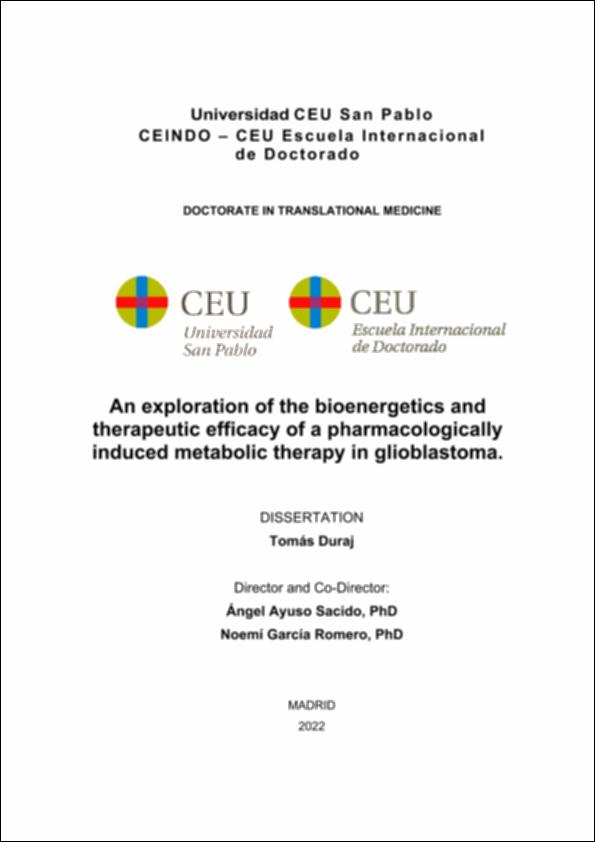Please use this identifier to cite or link to this item:
http://hdl.handle.net/10637/13791An exploration of the bioenergetics and therapeutic efficacy of a pharmacologically induced metabolic therapy in glioblastoma.
| Title: | An exploration of the bioenergetics and therapeutic efficacy of a pharmacologically induced metabolic therapy in glioblastoma. |
| Authors : | Duraj, Tomás |
| Keywords: | Cáncer; glioblastoma; metabolismo energético; glucólisis; efecto Warburg; fosforilación oxidativa; terapia metabólica; energy metabolism; glycolysis; Warburg effect; oxidative phosphorylation; metabolic therapy |
| Abstract: | El glioblastoma (GBM) es el tumor cerebral primario más agresivo. La patogenia es compleja, con participación de disfunción mitocondrial, señalización oncogénica y reprogramación metabólica. La terapia dirigida es un desafío por la alta heterogeneidad intratumoral. En este trabajo caracterizamos 3 líneas de células madre de glioma (GSC), así como U87MG, comprobando el potencial antiproliferativo de metformina (MF), dicloroacetato (DCA), oxamato de sodio (SOD) y diazo-5-oxo-L-norleucina (DON). Describimos que GBM27 (una línea dependiente de oxígeno) fue la más resistente a todos los tratamientos, excepto DON. La aplicación de DON disminuyó la producción total de ATP, pero con una respuesta metabólica más heterogénea. La inhibición efectiva de GSCs dependientes de oxígeno sería tóxica para células normales: esto podría evitarse mediante reducción de dosis. La bleomicina mostró sinergia en combinación con MF, DCA y DON en GBM27, y con DON en todas las líneas celulares. U87MG no fue capaz de adaptarse a la restricción de glucosa y glutamina, a pesar de la presencia de cuerpos cetónicos. La depleción cíclica provocó cambios morfológicos y un fenotipo metabólico quiescente. Nuestra investigación subraya la necesidad de una mejor caracterización del GBM desde una perspectiva metabólica. Revertir la dependencia a fuentes de energía fermentables merece futuras investigaciones. Glioblastoma (GBM) is the most aggressive primary brain tumor. Pathogenesis is complex, with involvement of mitochondrial dysfunction, oncogenic signaling and metabolic rewiring. Targeting metabolic vulnerabilities of GBM remains challenging due to high intratumoral heterogeneity. We characterized the bioenergetic phenotypes of 3 distinct glioma stem cells (GSCs), as well as non-stem U87MG, testing the antiproliferative potential of metformin (MF), dichloroacetate (DCA), sodium oxamate (SOD) and diazo-5-oxo-L-norleucine (DON). We found that GBM27, highly oxygen-dependent, was the most resistant to all treatments except DON. DON decreased total ATP production, but demonstrated heterogeneous metabolic responses, suggesting a multidimensional role of glutamine in cellular bioenergetics. Effective targeting of oxygen-dependent GSCs would be toxic to normal cells. Circumventing toxicity entails dose-reduction strategies. Bleomycin exhibited therapeutically relevant synergistic effects with MF, DCA and DON in GBM27, and DON in all other cell lines. Archetypal of non-stem populations, U87MG was not able to adapt to long-term glucose and glutamine depletion despite the presence of ketone bodies. Cyclical ketone-compensated glucose depletion induced growth arrest, morphological changes, and a quiescent metabolic phenotype. Our study highlights the need for better characterization of GBM from a metabolic perspective. Exploiting cancer addiction to fermentable energy sources warrants further exploration. |
| Description: | Tesis-CEINDO, Universidad San Pablo CEU, Facultad de Medicina, Programa en Medicina Traslacional, leida el 11 de mayo del 2022 |
| Director(s): | Ayuso Sacido, Ángel García Romero, Noemí |
| URI: | http://hdl.handle.net/10637/13791 |
| Rights : | http://creativecommons.org/licenses/by-nc-nd/4.0/deed.es |
| Issue Date: | 10-Jun-2022 |
| Center : | Universidad San Pablo-CEU |
| Appears in Collections: | Medicina Traslacional |
Items in DSpace are protected by copyright, with all rights reserved, unless otherwise indicated.


